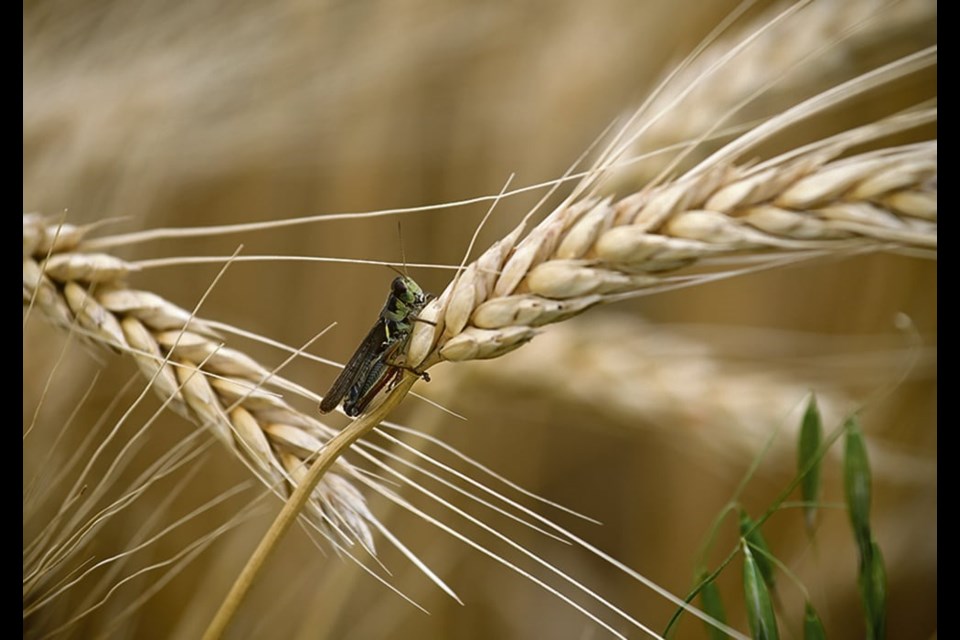WESTERN PRODUCER — Expect more grasshoppers next year if weather and growing conditions mimic those of last season, says a provincial entomologist.
“The forecast is a bit worrisome in large part because of their population development,” said James Tansey, Saskatchewan Agriculture’s pest management specialist.
“The population increase or decrease depends very much on weather conditions and we had conditions that were favourable for large numbers of grasshoppers to mate and to get eggs into the ground. That has to do very much with a long, dry, warm, mid-summer to late summer and early fall,” said Tansey during an agronomy research update hosted by crops extension specialists and held in Saskatoon.
“We had early emergence of nymph grasshoppers, so a relatively early hatch associated with the warm weather. They got through their juvenile development relatively quickly.”
Last year, eastern regions of Saskatchewan had respite from grasshoppers, compared to central and southern regions, because of chilly, damp conditions and the resulting delayed emergence.
“It all depends on what happens in the spring. We get a cool wet spring, that can have a really negative impact on grasshopper populations, even large numbers of grasshoppers.
“But if things are warm and dry in the spring and continue through the growing season, I think we may be setting ourselves up for some problems,” he said.
As grasshopper numbers swelled, so did natural predator populations. They include field crickets and blister beetles.
“Field crickets are ravenous munchers of grasshopper eggs. We also saw last year some sites with very large numbers of blister beetles, and they are important predators, or at least their larvae are, of grasshopper eggs,” Tansey said.
There were also regional reports of fungal and bacterial infections attacking some grasshopper species but in relatively small areas and individual fields.
“Timely rains in the spring may have had a negative impact on some of those populations and this may be reflected in what we’re seeing with the grasshopper forecast.”
Tansey said bertha armyworms could also be a concern in the next growing season. They are major canola pests and typically run on an eight-year cycle.
“Our trapping data indicates that they’re at a bit of a low ebb right now, but they could be ramping up. We could see an increase in their populations and the really simple model that I’ve developed suggests that they may increase. We’re going to continue to monitor that one.”
Diamondback moths could also be an issue but levels are difficult to predict because of migratory patterns.
“Everything with their arrival depends in large part on conductivity with high altitude rivers of air, essentially between their southern range of Texas, Florida, northern Mexico and the central Plains here. Without that conductivity, they won’t be able to cover those hundreds of kilometres per day. They need those winds to travel those great distances.
“It also depends on conditions in the regions that they’re leaving and on conditions here. If it’s warm and dry here when they arrive, they have the potential to increase rapidly and can then go through multiple generations,” he said.
Aphids, particularly pea aphids, are another migratory pest to watch for in pulse crops but numbers will depend on whether conditions in the U.S. growing season favour development.
Ambient temperature is an effective control because aphids don’t like heat. Even so, there was some pressure from pea aphids in 2022 despite relatively high temperatures.
“We’re looking at about nine percent survival of juveniles at 27 C. So, if it gets to be quite warm, that can really knock them down, especially if that’s coupled with dry conditions like we saw in 2021,” Tansey said.
Wheat aphids or cereal aphids such as the English grain aphid and birdcherry-oat aphid were also present last year.
Like many of the pest aphid species, they are controlled by natural enemies such as ladybird beetles, lacewings, damsel bugs and predatory mites.
“A lot of the small predators really like to munch on aphids, so they can have a pretty profound effect.”
Lygus bugs love heat, and while numbers were down in the past growing season, they had a big year in 2021. They’re susceptible to conditions of high relative humidity that can produce fungal infections. Rainfall can also have a big effect, especially by knocking juveniles off plants.
Tansey said the coming year’s pressures will depend on the type of pest and its response to different climate conditions.
“Concern about grasshoppers is strong and if we’re going to look at that one, then warm and dry. That’s where these ones are going to thrive. If we’re looking at wheat midge, then it’s all about timely rains. If we’re talking about pea aphids, then it’s moderate temperatures,” he said.
“The big asterisk is, it all depends.”
For more information, contact Tansey at [email protected]. He said the Ag Knowledge Centre in Moose Jaw is also a good source of direct information.
“Keep an eye on the Prairie Pest Monitoring Network because we’re going to have up-to-date information on each of these important pests.”

